Source: BANKLESS
Original Title: Ethereum's Store of Value Era
Translation and Compilation: BitpushNews
Yesterday, The DeFi Report released a data analysis report for the second quarter on Ethereum, revealing a network in transformation.
Despite a decline in protocol revenue and on-chain transaction fees due to the Pectra upgrade and the rise in Layer 2 usage, the report points out that a deeper trend is occurring: Ethereum is showing clear signs of transitioning from a "utility token" to a "store of value asset."
Here are the five key points from the report, providing a clear framework for Ethereum's transformation into a "monetary asset":
1. Institutions are buying ETH in large quantities
In the past quarter, ETH has entered institutional balance sheets at an unprecedented rate, primarily through two paths: ETFs and corporate treasuries.
ETH ETFs: The total assets under management increased by 20% quarter-over-quarter, reaching 4.1 million ETH, accounting for 3.4% of the total supply. This is the largest quarterly increase since tracking began, with Fidelity's FETH leading the inflow of funds.
Corporate Treasuries: ETH holdings increased by 5,829%, reaching 1.98 million ETH. SharpLink Gaming increased its holdings by 216,000 ETH, including direct purchases from the Ethereum Foundation; Bit Digital increased its holdings by over 100,000 ETH. A total of 48 institutions have included ETH in their treasuries.
Bitminer Chairman Tom Lee stated that they view ETH as a "stablecoin chip," suggesting that in the future, companies may operate their stablecoin networks by holding and staking ETH, which will further intensify institutional demand for ETH.
The DeFi Report believes this trend mirrors the early institutional adoption path of Bitcoin: ETFs and treasuries becoming major buyers, rather than being used for trading or paying gas fees, with ETH being redefined as a long-term store of value asset, leading to a contraction in circulation.
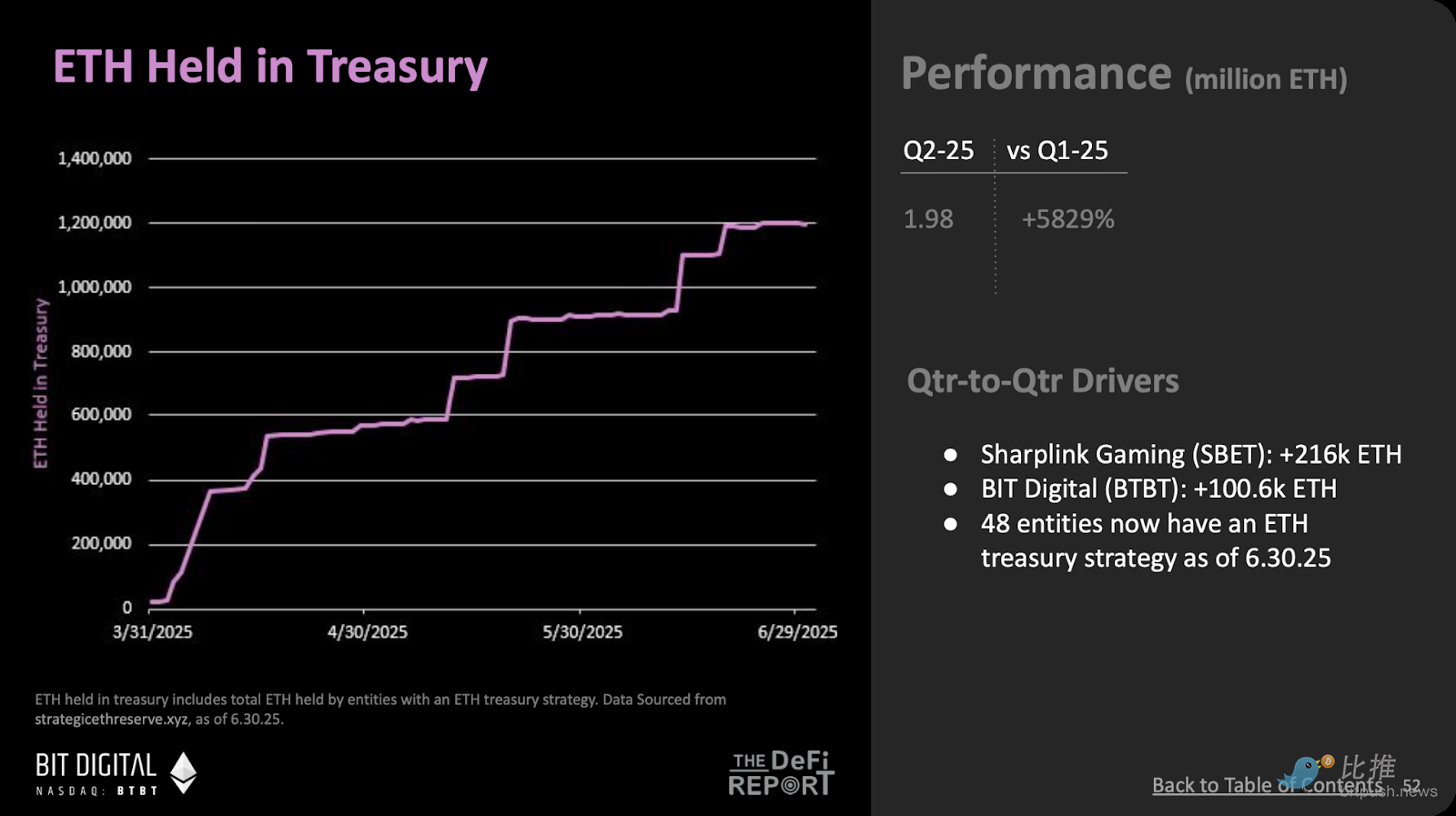
2. Funds are flowing out of exchanges and into long-term holdings
In the past quarter, ETH has steadily exited high-liquidity trading markets, shifting towards being locked or strategically held, which is typical behavior for a store of value asset.
Withdrawals from exchanges: ETH holdings in centralized exchanges decreased by 7%, likely moving to cold wallets, staking contracts, or institutional custody accounts, aligning with the rising staking ratio.
DeFi usage decreased: The proportion of ETH in smart contracts dropped by 4% to 43%. However, this does not indicate selling; rather, users may choose to re-stake or allocate to ETFs.
This quarter, the circulating supply of ETH grew by only 0.18%, indicating that even with slight inflation in the network, the market can still effectively absorb new issuance.
The DeFi Report points out that this behavior is similar to the "dollar hoarding" phenomenon during times of economic uncertainty—users choose to store value in ETH rather than engage in frequent trading or speculation.
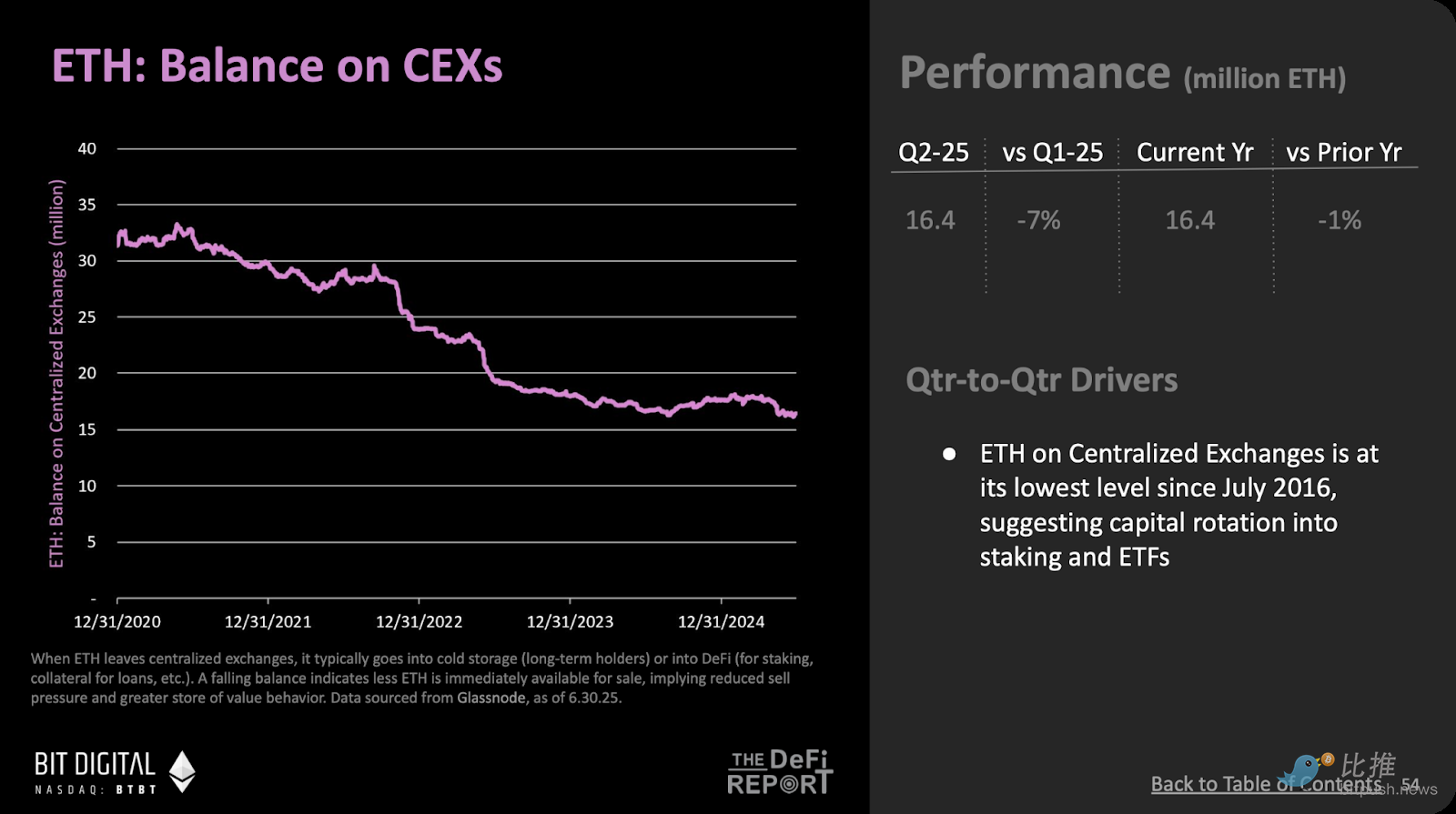
3. Staking has become an important vehicle for passive income from ETH
The ETH staking mechanism is shaping it into an interest-bearing store of value asset, with its continuous growth reflecting the market's long-term confidence in the asset.
Total staked ETH: Increased by 4%, reaching 35.6 million ETH, accounting for 29.5% of the supply, setting a new historical high. Despite reduced transaction fees after the Pectra upgrade, staking still provides substantial returns, with issuance rewards averaging 2,685 ETH per day and an annualized yield of 3.22%.
Reward structure: 88% of validator rewards come from newly issued ETH rather than on-chain fees. This also means that ETH itself is becoming a "yield-generating asset."
This makes ETH more akin to a "yield-bearing treasury bond" rather than merely a speculative asset. The staking mechanism is transforming Ethereum from a "transaction chain" into a "monetary network."
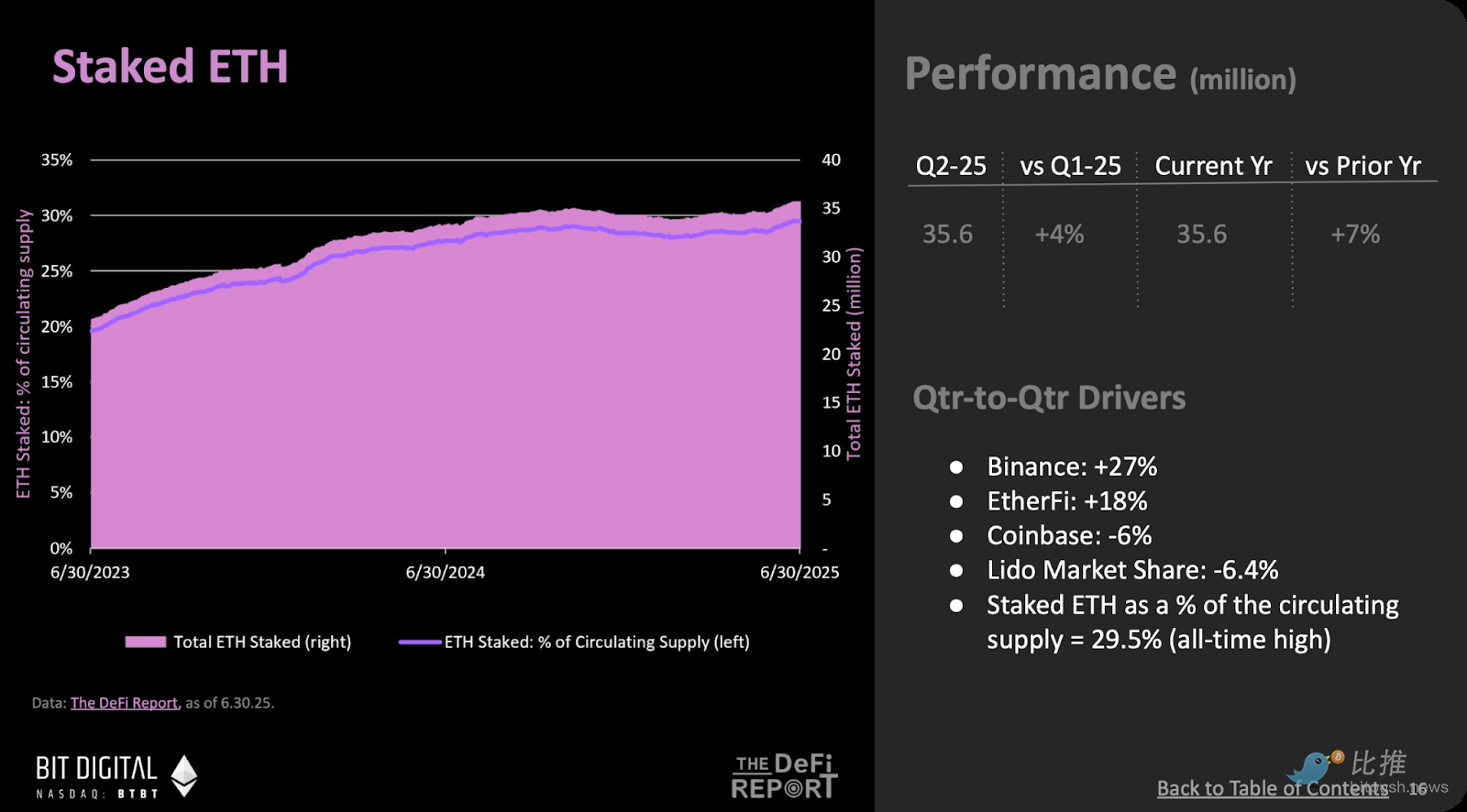
4. Inflation returns, but ETH has matured
Although ETH's net inflation appears to be a bearish signal, the DeFi Report believes this marks a structural maturity for ETH.
Increase in ETH issuance: This quarter, the total issuance of ETH increased by 2%, while the amount burned decreased by 55%, resulting in an annualized net inflation rate of 0.73%, the highest in a year.
Decrease in on-chain efficiency: The production cost of on-chain yield per unit increased by 58%, while actual on-chain yield decreased by 28%.
Despite the return of inflation, the market did not sell off; instead, staking pools and ETFs continued to absorb ETH. DeFi Report founder Michael Debault noted that this phenomenon is similar to the early cycles of Bitcoin—users accept a certain level of inflation in exchange for the long-term security and sustainability of the network.
Today, ETH resembles a monetary system with "planned inflation" and "embedded yield," differing from traditional public chain assets. More importantly, even with weak economic data, holders remain confident, and this behavior of "not selling through inflation" is a core characteristic of a store of value asset.
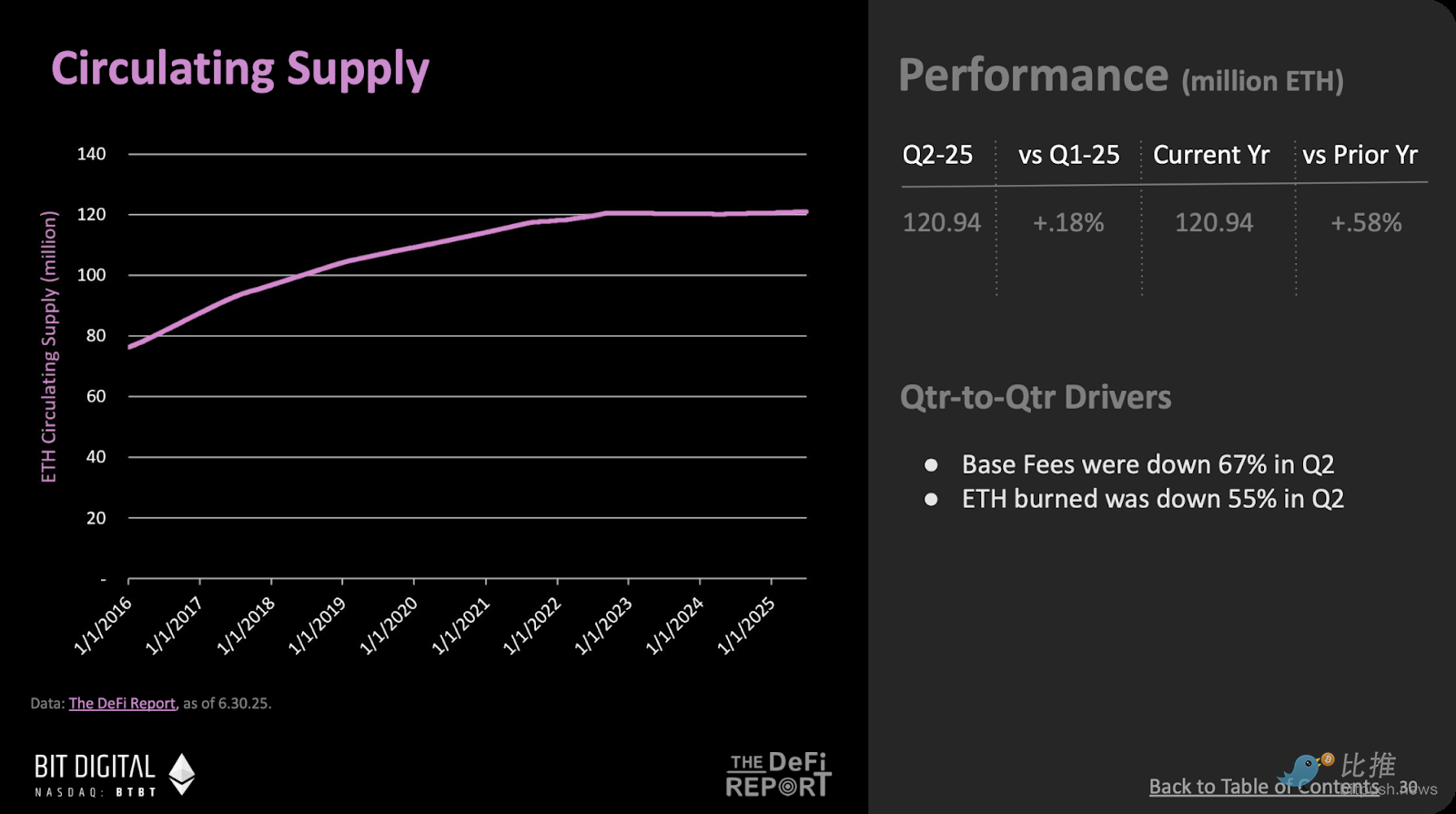
5. The Ethereum mainnet is becoming a "settlement layer"
Ethereum Layer 1 is gradually relinquishing its role as a "transaction engine," transforming into a foundational layer for capital carrying and final settlement—characteristics of a monetary network.
Surge in L2 activity: Layer 2's daily transaction volume is 12.7 times that of the mainnet, and the number of active addresses is 5 times that of the mainnet; the number of high-interaction smart contracts on L2 is 5.7 times that of the mainnet; DeFi transaction speeds also lead the mainnet by 7.5 times.
The mainnet remains an asset anchor: Despite the migration of trading activity to L2, the mainnet's TVL (Total Value Locked) still increased by 33%. The scale of real-world assets (RWA) grew by 48% this quarter, reaching $7.5 billion, primarily consisting of tokenized government bonds and commodities.
The DeFi Report believes this pattern resembles the traditional financial system: secondary platforms are responsible for trading and operations, while the main layer is responsible for final settlement. The Ethereum mainnet serves as a "bulletproof block space," with ETH as its core reserve asset.
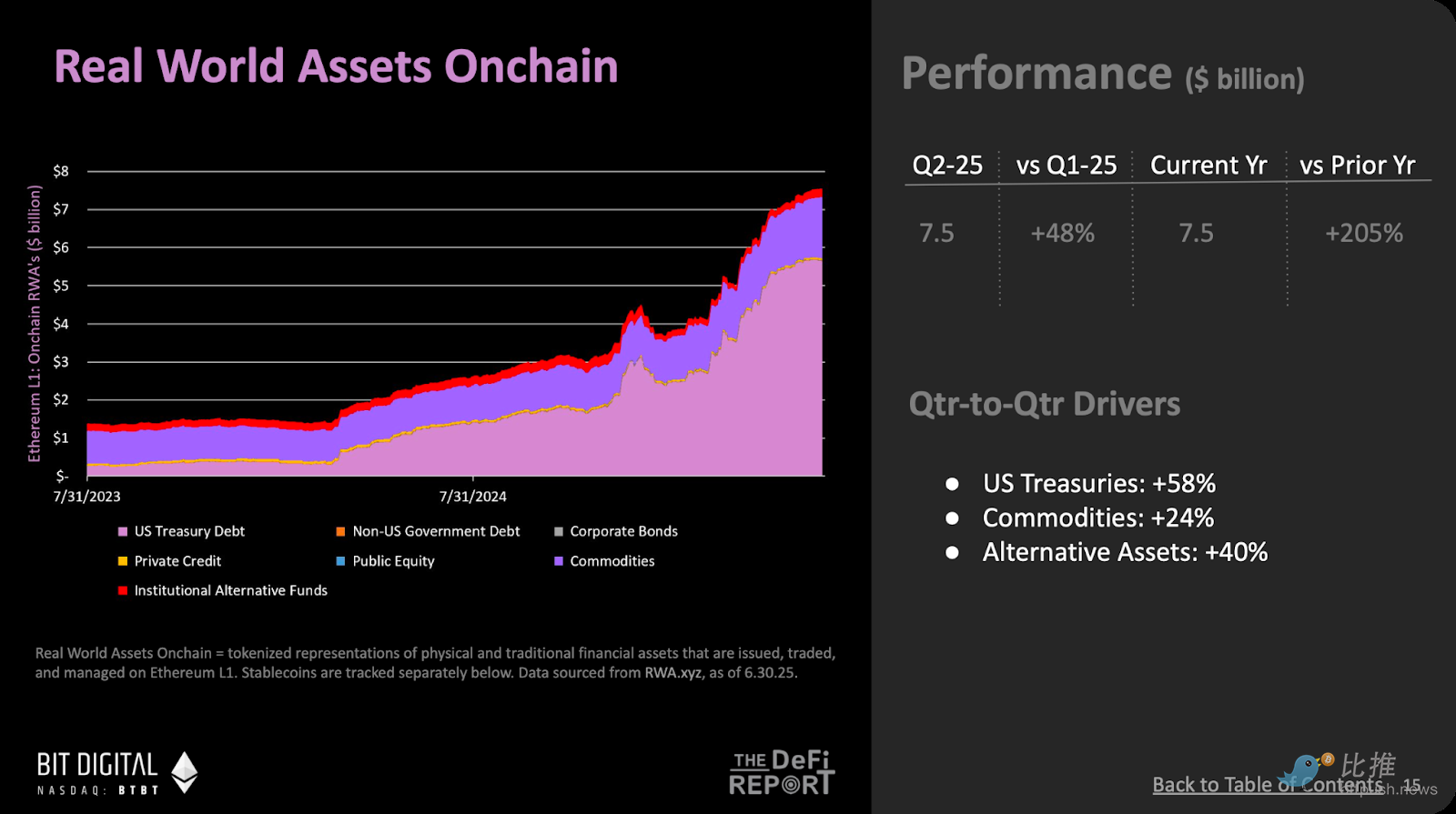
Conclusion: ETH is becoming a "sovereign monetary asset"
The Q2 report clearly depicts ETH's trajectory from a "utility token" to a "sovereign bond."
Whether through ETFs, treasuries, or staking contracts, ETH is gradually exiting high-frequency trading environments and shifting towards long-term holding. Layer 2 has taken on execution layer functions, while the Ethereum mainnet has solidified as a capital platform and anchor for real assets. Staking rewards primarily come from issuance rather than transaction fees, with the structure increasingly resembling early monetary systems.
In other words: ETH is no longer just fuel; it has become an inseparable value carrier of the network itself.
免责声明:本文章仅代表作者个人观点,不代表本平台的立场和观点。本文章仅供信息分享,不构成对任何人的任何投资建议。用户与作者之间的任何争议,与本平台无关。如网页中刊载的文章或图片涉及侵权,请提供相关的权利证明和身份证明发送邮件到support@aicoin.com,本平台相关工作人员将会进行核查。




